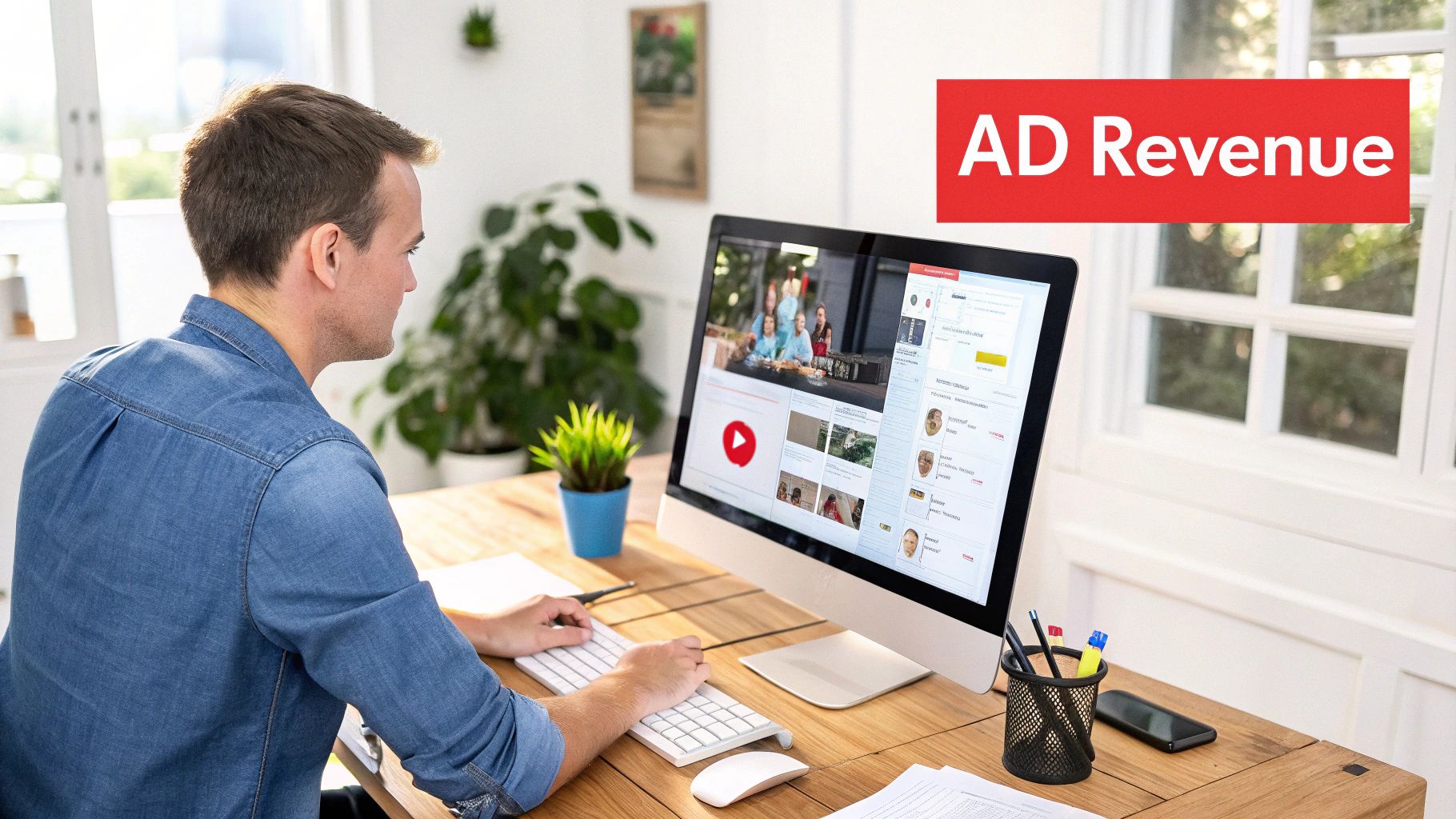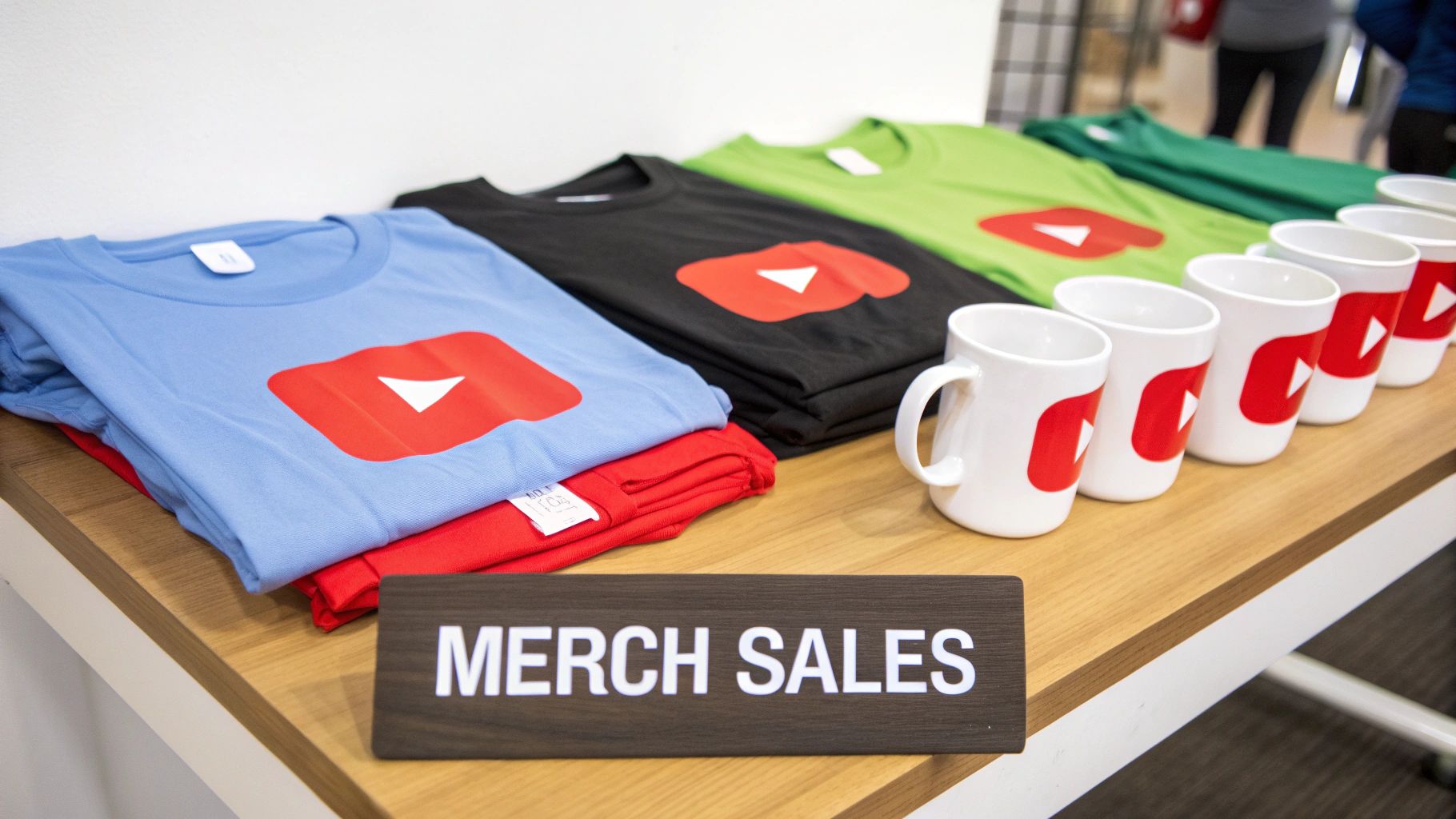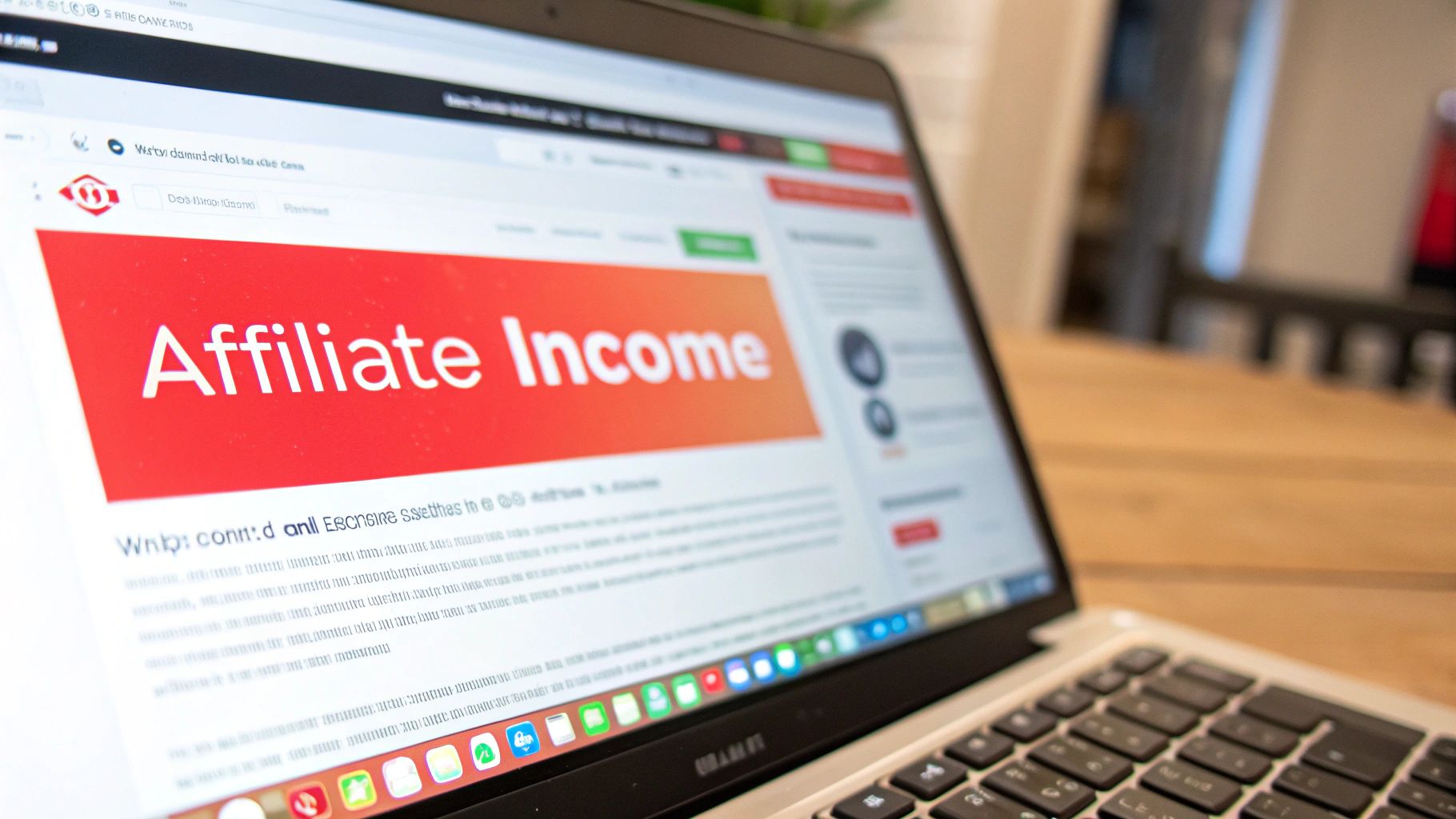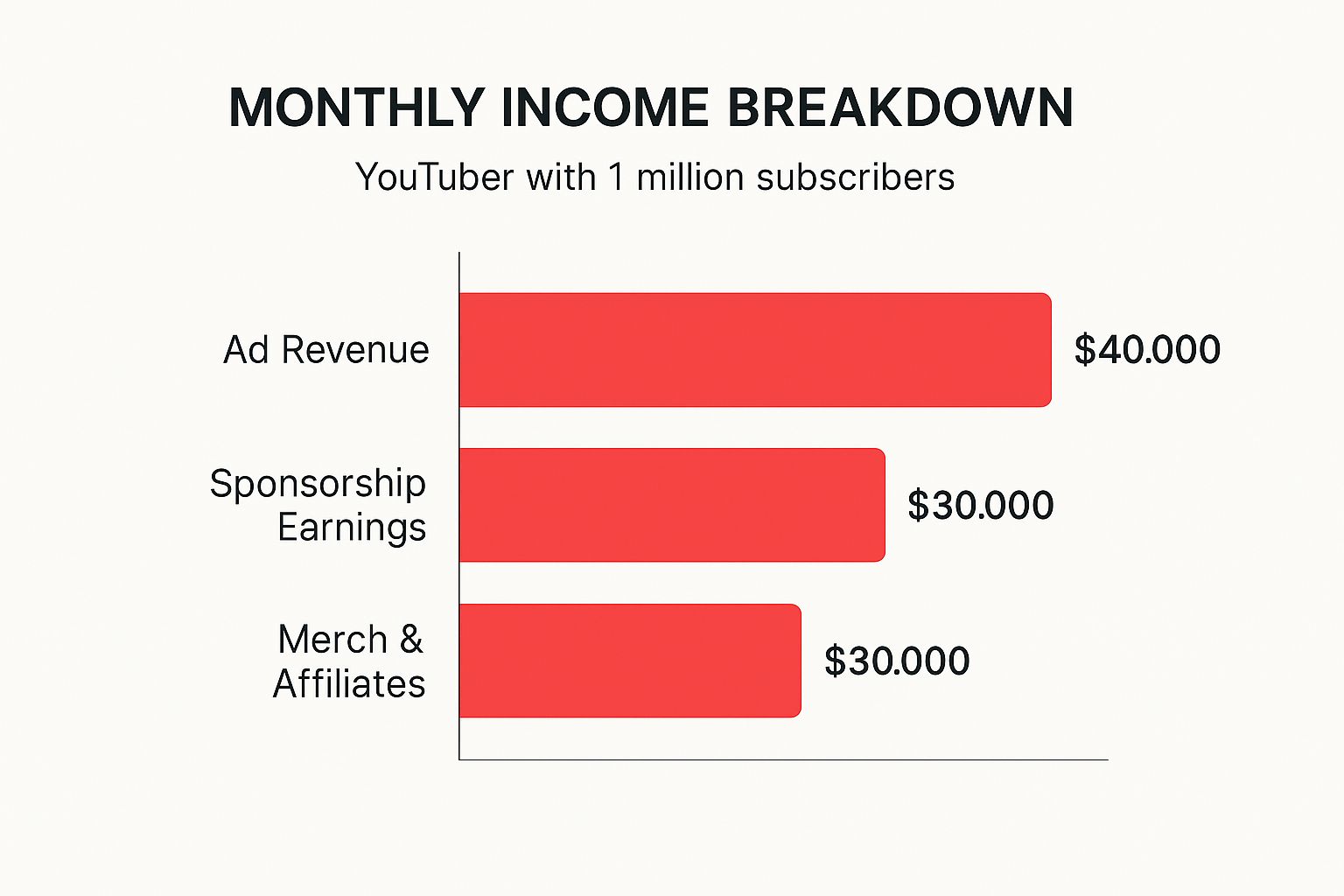Hitting the one-million-subscriber mark on YouTube is a huge deal, but what does it actually mean for your wallet? The truth is, a YouTuber with a million subscribers can make anywhere from $5,000 to over $50,000 per month.
That's a massive range, and it's because a creator's income isn't directly tied to their subscriber count. Think of subscribers as your built-in audience, not your direct paycheck. The real money comes from a mix of views, engagement, and the different ways you monetize that audience.
How Much Do YouTubers With 1 Million Subscribers Really Earn?

It’s crucial to understand that reaching a million subscribers doesn't unlock some kind of fixed salary from YouTube. What it does is open the door to serious earning potential, but you have to build it yourself. The money isn't just about having people subscribed; it’s about what they do—like watching ads, clicking affiliate links, or buying your merch.
This is exactly why two channels, both with a million subs, can have wildly different bank balances. One might be getting by on ad revenue alone, while the other is running a full-blown business with multiple income streams.
Key Factors That Determine Your Monthly Paycheck
Your monthly income really comes down to how you manage the different parts of your channel. It’s less about one specific number and more about the entire ecosystem you create around your content. For a more detailed look at the numbers, our guide on how to calculate your potential YouTube income breaks it all down with proven strategies.
Here are the main things that will move the needle on your earnings:
- Your Niche: The topic you cover is probably the single biggest factor. Niches like finance or tech attract advertisers who are willing to pay big money to reach that specific audience.
- Audience Location: Where your viewers are from matters a lot. An audience from a country with high ad spend, like the United States or the UK, is much more valuable to advertisers.
- Engagement Rate: A smaller, super-engaged audience that actually watches your videos and trusts your recommendations is way more profitable than a massive, passive one.
- Multiple Revenue Streams: This is huge. Relying only on AdSense is a classic beginner's mistake. The top earners diversify with sponsorships, affiliate marketing, merch, and more.
The biggest misconception is that subscribers equal money. In reality, subscribers equal opportunity. They give you a loyal audience to monetize through views, sponsorships, and direct sales.
Why Your Niche Matters So Much
Let’s put this into perspective with a real-world example. A YouTuber in the personal finance space might earn between $5,700 to $6,100 per million views. Why so high? Because advertisers in that industry are paying top dollar to get in front of people interested in investing or financial products.
On the other hand, a channel in a broader entertainment or vlogging niche might only see $2,000 to $3,000 for the exact same number of views. This shows that choosing your niche isn't just a creative decision—it's one of the most important business decisions you'll make.
The table below gives you a quick snapshot of how earnings can vary across different income streams for a channel with a million subscribers.
Estimated Monthly Income Range for a 1 Million Subscriber Channel
This table provides a quick overview of potential monthly earnings from different sources for a typical 1 million subscriber channel, illustrating the variability in income.
| Income Source | Low Estimate (Per Month) | High Estimate (Per Month) | Key Influencing Factor |
|---|---|---|---|
| Ad Revenue (AdSense) | $2,000 | $10,000 | Content niche and audience location |
| Sponsorships | $3,000 | $25,000 | Brand deal quality and negotiation |
| Affiliate Marketing | $500 | $10,000+ | Audience trust and product relevance |
| Merchandise Sales | $500 | $5,000+ | Brand loyalty and product design |
As you can see, the real money often lies beyond just ad revenue. Building a diverse income portfolio is the key to maximizing your earnings and creating a sustainable career as a creator.
How YouTube Ad Revenue Actually Works
For most creators, ads are the first real paycheck they see from YouTube. It’s the money that starts rolling in once you join the YouTube Partner Program (YPP) and let ads play on your videos.
But figuring out how much you'll make from ads isn't as simple as just counting your views. You need to understand two little acronyms that get thrown around a lot: CPM and RPM. They sound similar, but they tell two very different stories about your income.
Think of it this way: imagine you own a billboard. CPM is the price a company pays to put their ad on your billboard. RPM is the money that actually ends up in your pocket after the billboard company takes its cut for maintenance and sales.
The Real Difference Between CPM and RPM
CPM stands for Cost Per Mille (mille means "thousand" in Latin). It’s the amount advertisers pay YouTube for every 1,000 times their ad is shown on videos like yours. A high CPM means your audience is a hot commodity for advertisers.
But here’s the catch: you don’t keep all of it. YouTube takes a 45% cut of the ad revenue from your channel. That’s where the second number, RPM, becomes so important.
RPM stands for Revenue Per Mille. This is what you actually earn for every 1,000 views your videos get, after YouTube has taken its share. This is the number that matters. It’s the cash that hits your bank account.
The Bottom Line: CPM is what advertisers pay. RPM is what you earn. When you're trying to figure out your 1 million subscribers YouTube income per month, always focus on your RPM.
Let's break it down with a quick example:
- An advertiser pays a $10 CPM to run ads on your content.
- Your video gets 100,000 views where an ad is successfully shown.
- That generates $1,000 in total ad spend ($10 CPM x 100).
- YouTube takes its 45% cut, which is $450.
- You’re left with $550. This means your RPM for these views is $5.50.
See? A high CPM is great, but your RPM is the true measure of your channel's ad performance.
Not All Ads Are Created Equal
The type of ads running on your videos also makes a huge difference. The format a viewer sees can dramatically change what you earn from that one view, so knowing the difference helps you make smarter choices.
Here are the main ad formats you’ll see:
- Skippable In-Stream Ads: The classic "skip ad" button. These are the ads that play before or during a video, and you only get paid if a viewer watches for at least 30 seconds or clicks on the ad.
- Non-Skippable In-Stream Ads: These are shorter ads (usually 15-20 seconds) that have to be watched all the way through. They typically pay a bit less than a fully watched skippable ad, but the revenue is guaranteed.
- Bumper Ads: Quick, 6-second ads that can't be skipped. They don't pay much individually, but they can add up across millions of views.
- Display Ads: These are the banner ads that pop up next to your video on a desktop computer. You earn money when someone sees or clicks on them.
One of the biggest levers you can pull is placing mid-roll ads in videos longer than eight minutes. This strategic placement is a key way to boost your RPM.
Real-World Ad Revenue Scenarios
Alright, let's put this all together and look at two different channels that both have one million subscribers. This will show you exactly why your niche is everything when it comes to ad money.
Channel A: The Gamer
- Niche: Fortnite highlights and funny moments.
- Audience: Mostly teenagers from all over the world.
- Average RPM: $3.50
- Monthly Views: 5 million
- Estimated Monthly Ad Revenue: $17,500 (5,000 x $3.50)
Channel B: The Finance Guru
- Niche: Investing tips and retirement planning.
- Audience: Adults aged 30-55, mostly in the US and UK.
- Average RPM: $18.00
- Monthly Views: 5 million
- Estimated Monthly Ad Revenue: $90,000 (5,000 x $18.00)
Look at that difference. Same subscriber count, same number of monthly views, but the income is worlds apart. The finance channel’s RPM is more than five times higher because advertisers selling high-ticket items (like investment platforms and financial services) are willing to pay a fortune to reach that audience.
If you want to see just how much earnings can vary, this complete YouTube CPM by category revenue guide breaks it down topic by topic.
This is proof that just chasing views isn't the best strategy. You have to attract the right views from an audience that advertisers can't wait to get in front of.
Building Income Streams Beyond AdSense

While AdSense is the starting point for making money on YouTube, the pros with a million subscribers know it's just one slice of a much bigger pie. Relying only on ad revenue is like building your house on a single pillar—it’s just too risky. YouTube can tweak its ad policies, your RPM can swing wildly, or a few videos might just flop, causing your income to take a nosedive.
This is why the biggest creators don't just run a channel; they build a business. They spread their bets across different income sources to create a stable, predictable financial future. Thinking beyond ads is what turns your channel from a hobby that pays the bills into a full-fledged media company.
Unlocking The Power Of Brand Sponsorships
For established creators, brand sponsorships are often the single biggest moneymaker. This is when a company pays you to talk about their product or service in one of your videos. Unlike AdSense, which might pay you fractions of a cent per view, a single brand deal can be worth thousands of dollars.
For a channel with a million subscribers, a typical sponsorship can range anywhere from $5,000 to over $30,000 for one integrated mention. The final number really depends on your niche, who your audience is, and how many views you typically get. A tech channel reviewing expensive cameras will always get higher offers than a general comedy channel because their audience is clearly ready to buy.
Cutting these deals is a real skill. You're not just selling a quick shout-out; you're selling the trust you've built with your community. That means you have to pick partners whose products actually make sense for your content and your audience.
Creating Passive Income With Affiliate Marketing
Affiliate marketing is another fantastic way to cash in on the trust you've built. The idea is simple: you recommend a product you genuinely use and love, and you drop a special tracking link in your video description. When someone clicks that link and buys something, you get a commission.
Think of it as a digital finders fee. You’re pointing your audience toward cool stuff and getting a thank-you kickback from the brand for making the introduction. For a creator with a million subscribers, this can quickly add up to a serious source of passive income.
Here’s the basic playbook:
- Find Relevant Products: Team up with brands that fit your niche. A fitness creator might partner with a supplement company, while a gaming channel could link to the mouse and keyboard they use.
- Use Unique Links: The brand gives you a custom link or discount code that tracks every sale that comes from your channel.
- Promote Authentically: Weave the product into your content naturally. Explain why you use it. Your audience can spot a phony, forced ad from a mile away.
The best part about affiliate marketing? A video you posted a year ago can keep making you money today as new people discover it and click those links. Exploring different strategies for monetizing influencer content can give you fresh ideas, even if they're from unexpected places.
Selling Your Own Products And Merchandise
This is the final boss of being a creator: selling your own stuff. It’s where you’ll find the best profit margins because you control everything, from the design to the final sale. Once you hit the one-million-subscriber mark, you have a built-in community that genuinely wants to support you.
There are two main routes creators take here:
- Physical Merchandise: This is the classic path. We're talking t-shirts, hoodies, mugs, and hats with your logo or an inside joke from the channel. Services like Teespring or Represent make it super easy to get started without having to store boxes of inventory in your garage.
- Digital Products: This is where a lot of creators find even bigger wins. Digital products cost almost nothing to distribute and can be sold an infinite number of times. Think e-books, online courses, workout plans, photo presets, or exclusive video content.
By building multiple streams of revenue, you're protecting your business from the platform's ups and downs. If ad rates tank one month, a great merch drop can more than make up for it. This is how a 1 million subscribers YouTube income per month transforms from a fluctuating paycheck into a stable business.
Ultimately, diversifying your income is all about building a direct relationship with your audience. If you want to dive deeper into this strategy, check out our guide on https://monetizedprofiles.com/blogs/monetization-on-social-media/how-to-build-multiple-income-streams. The most successful creators know their YouTube channel is just the front door to a much larger business.
Views and Engagement Are King, Not Subscribers
Here's a tough pill to swallow for a lot of new creators: YouTube doesn't pay you for subscribers. It’s a huge misconception. Your subscriber count is a milestone, for sure—an incredible one at that—but it’s not what puts money in your bank account.
Think of your subscriber list like a VIP list for a new restaurant. It’s a group of people who’ve said, "Hey, I like what you're doing, keep me in the loop!" But you only get paid when they actually walk through the door and order something. On YouTube, that "order" is them watching your videos and the ads that run on them.
That’s why hitting one million subscribers feels more like getting the keys to a bigger venue than winning the lottery. You have a massive built-in audience ready to see what you do next, which is a powerful signal to the YouTube algorithm. But if they don't show up, that number is just for show.
Debunking the Subscriber Pay Myth
It’s so easy to fall into the trap of thinking more subscribers automatically equals more money. But the reality on the platform is way more interesting than that. I’ve seen channels with 500,000 die-hard fans easily out-earn channels with 2 million subscribers who just don't watch anymore.
Engagement is the real currency on YouTube. Things like watch time, likes, comments, and shares tell YouTube and potential sponsors that people aren't just subscribed—they're genuinely invested.
Focusing on just that big subscriber number is playing the short game. The real win comes from building a community that actually cares about what you have to say.
How Engagement Multiplies Your Income
An active, engaged audience is a financial game-changer. It doesn't just bump up your ad revenue; it creates a positive ripple effect that boosts every single way you make money.
- Better Sponsorship Deals: Brands aren't just buying views; they're buying influence. When they see a creator with a super-engaged comment section, they know that audience trusts you. That trust lets you negotiate much, much higher rates.
- Higher Affiliate Commissions: An engaged viewer is way more likely to take your recommendation seriously. When you suggest a product you love, they actually listen, click the link, and make a purchase.
- Successful Merch Sales: A loyal community wants to support you. They’re not just watching your content; they’re part of your journey. When you drop a new line of merch or a digital course, they're the first ones to pull out their wallets.
A passive subscriber is just a number on a screen. An engaged viewer is a potential customer, a brand advocate, and the person who turns your channel from a hobby into a real business.
Of course, reaching 1 million subscribers is a massive achievement that YouTube celebrates with a Gold Creator Award. It’s a huge deal! But it's not a direct measure of income. For a channel of this size, ad revenue alone typically falls between $4,500 and $6,000 per month. The real magic happens when you add in other income streams, which can push your annual earnings well into six figures. You can find more detailed breakdowns on this from experts like Creator Hero.
Focus on Quality Views, Not Just a Big Subscriber List
At the end of the day, a healthy 1 million subscribers YouTube income per month is built on quality views, not just a flashy subscriber count. A "quality view" is one from someone who's genuinely into your content, watches for a long time, and happens to be in a demographic advertisers are willing to pay more to reach.
Your goal should be to create videos so good that people can’t help but watch, comment, and share. Talk to your community in the comments, make them feel seen, and build that loyalty. That’s the stuff that translates directly into a stable, predictable income.
Your subscriber count is your potential. Your views and engagement are your profit.
How Niche and Audience Location Impact Your Earnings

It’s easy to assume that a million views is a million views. On YouTube, that couldn't be further from the truth. Two key factors can make one view worth ten times more than another: your channel's niche and your audience's location.
These aren't just minor details; they are the hidden levers that separate creators earning a modest living from those running a seven-figure business.
Imagine two channels. Both have a million subscribers and pull in five million views a month. Channel A talks about celebrity gossip, while Channel B covers cryptocurrency investing. Even with the exact same viewership, the crypto channel will almost always earn dramatically more from ad revenue. Why?
It all comes down to what advertisers are really buying. They aren't just paying for eyeballs; they're paying for access to specific audiences. They are willing to bid much more to get their ads in front of people who are likely to buy high-value products. A viewer watching a stock trading video is seen as a much more lucrative customer than someone watching a prank compilation.
Why Your Niche Can Make or Break Your Paycheck
The topic you choose for your channel is probably the single biggest factor determining your RPM—the revenue you actually pocket per 1,000 views. Some subjects are just magnets for big-spending advertisers, and that directly inflates your income potential.
-
High-Profit Niches: Think about topics like personal finance, technology, real estate, and business. The advertisers here are banks, software companies, and investment firms. They sell expensive products and have massive marketing budgets, so they'll pay a premium to reach your audience.
-
Lower-Profit Niches: Content like gaming, daily vlogs, and general entertainment often brings in lower RPMs. These niches can get monster view counts, but the advertisers are usually selling lower-cost items (like energy drinks or mobile games) and there's a ton of competition, which pushes ad rates down.
Think of it like real estate. A tiny storefront on Fifth Avenue in New York City brings in more rent than a giant warehouse in a rural town. The location is everything. In YouTube terms, a finance video is your Fifth Avenue property.
A finance creator with a million subscribers might see an RPM of $15-$25. A vlogger with the exact same audience size might only get an RPM of $2-$5. When you multiply that difference by millions of views, the gap becomes absolutely staggering.
To give you a clearer picture, let's look at how different niches stack up. Some content categories are simply more attractive to advertisers with deep pockets, which translates directly into higher CPMs and RPMs for creators.
YouTube Niche vs. Estimated CPM/RPM
| Content Niche | Typical CPM Range | Advertiser Interest Level | Audience Profile |
|---|---|---|---|
| Personal Finance & Investing | $20 - $50+ | Very High | High-intent, often with disposable income |
| Technology & Software Reviews | $15 - $40 | High | Tech-savvy, early adopters, decision-makers |
| Real Estate | $12 - $35 | High | Actively looking to buy, sell, or invest |
| Business & Marketing | $10 - $30 | High | Entrepreneurs, professionals, B2B buyers |
| Beauty & Fashion | $5 - $15 | Medium | Engaged consumers, brand-loyal |
| Gaming & Entertainment | $2 - $8 | Low to Medium | Broad, younger demographic, lower purchase intent |
| Vlogging & Lifestyle | $2 - $6 | Low | General audience, less targeted for specific products |
As you can see, choosing a niche with a high-value audience is one of the most strategic decisions a creator can make to maximize their ad revenue.
The Geographic Lottery: Where Your Audience Lives Matters
The second piece of the puzzle is the physical location of your viewers. Advertisers set their budgets on a country-by-country basis, and companies in wealthier nations just spend more on ads. Plain and simple. This means a view from someone in the United States is worth a lot more than a view from many other parts of the world.
This is what many creators call the "geographic lottery."
You could make the exact same video, but if most of your audience lives in a region with low ad spend, your earnings will be a fraction of what they could be. Here’s a rough breakdown of how countries are often tiered:
- Tier 1 Countries: United States, United Kingdom, Canada, Australia. These have the highest ad rates and are the holy grail for most advertisers.
- Tier 2 Countries: Developed nations in Europe and Asia, like Germany, France, and Japan. Ad rates are still strong, just a step below Tier 1.
- Tier 3 Countries: Includes many countries in Latin America, Southeast Asia, and Eastern Europe, where ad spending is significantly lower.
Let's put it into perspective. A creator whose audience is 80% from the United States might have an RPM of $12. Another creator with an identical channel but an 80% audience from India might see an RPM closer to $1.50. It's not about the quality of the content—it's pure market economics.
This is why savvy creators are glued to their YouTube Analytics. They study their audience demographics and sometimes even create content specifically designed to attract viewers from these higher-paying regions.
Your Game Plan for Maximizing YouTube Income
Hitting one million subscribers is a massive win, but turning that milestone into a real, sustainable business is a whole different ballgame. It's less about the subscriber count and more about strategy. This checklist is your road map for taking that amazing audience you've built and solidifying your financial success as a top-tier creator.
Think of it this way: you're not just a YouTuber anymore; you're the CEO of a media company. Focusing on these key areas will make sure you're not leaving any money on the table.
-
Go for Higher RPMs: Don't just make videos; make videos that attract premium advertisers. Focus on high-value niches and target audiences in Tier-1 countries. Dive into your YouTube Studio data and find out which videos already have the highest RPM. Then, make more content like that.
-
Branch Out Beyond AdSense: Relying only on ad revenue is a rookie mistake. You need to diversify. Start actively looking for brand sponsorships that actually fit your content, weave in affiliate links for products you genuinely use and love, and think about launching your own merch or digital products.
-
Build a Real Community: Your subscribers aren't just a number—they're your community. High engagement (likes, comments, shares) is the ultimate signal to brands that your audience trusts you. That trust is what lets you charge higher sponsorship fees and sell your own products successfully.
Protect Your Hard Work
Growing your channel is one thing, but protecting it is just as crucial. Copyright strikes are the fastest way to get your videos demonetized, wiping out hours of work and future income in an instant.
Taking the time to learn the rules is a non-negotiable part of the job. For example, understanding royalty-free music for your content and using proper licensing isn't just a small detail; it’s a simple step that protects your entire business from falling apart.
Here’s the bottom line: your subscriber count shows your potential, but your strategy determines your profit. A smart creator who diversifies their income and truly knows their audience will always out-earn someone who just chases views.
This image breaks down a pretty typical income split for a creator who has nailed their diversification strategy.

As you can see, ad revenue is often less than half the story. The real money for top creators comes from building a multi-stream approach.
Your Top YouTube Income Questions, Answered
Even after breaking down the numbers, it's natural to have lingering questions about how YouTube money really works. Let's tackle some of the most common ones people ask when they're thinking about that million-subscriber goal.
Can You Actually Live Off 1 Million YouTube Subscribers?
Yes, absolutely. For most creators, hitting one million subscribers means you’ve built an audience large enough to generate a very comfortable full-time income, often reaching well into the six-figure range each year.
But—and this is a big but—it’s not automatic. The subscriber number itself doesn't deposit cash into your bank account. Real financial success comes from building a smart business around your channel. A creator who diversifies with ad revenue, brand deals, affiliate links, and their own products can thrive. Someone who just relies on ads and hopes for the best might find themselves on a financial rollercoaster.
How Many Views Does It Take To Start Making Money?
You can officially start earning from ads the moment you’re accepted into the YouTube Partner Program (YPP). To get in, you need 1,000 subscribers and 4,000 hours of watch time on your channel. Once you're approved, the very next view on a monetized video technically makes you money.
The catch is that the earnings per view are incredibly small. A decent RPM might be $5, which means you earn $5 for every 1,000 views, not per view. So while you are getting paid, you need to be pulling in hundreds of thousands, or even millions, of views every month to see a paycheck that matters.
The big lesson here is that a stable 1 million subscribers YouTube income per month isn't built on one viral hit. It's the result of consistent viewership across all your videos, month in and month out.
Do YouTubers Get Paid if I Skip the Ads?
This one is a classic, and the answer is: it depends on the ad. For those common skippable ads that pop up before or during a video, the creator usually doesn't get paid if you hit "Skip Ad" before the 30-second mark (or before the ad ends, if it's shorter).
That said, skipping doesn't always mean the creator gets nothing. They still earn from other ad formats that viewers see, like:
- Non-skippable ads: Since you have to watch the whole thing, the creator gets paid.
- Bumper ads: Those quick, 6-second ads are non-skippable, so they generate a small amount of revenue.
- Display ads: The little banners you see on the side or overlaying a video can earn money from impressions or clicks.
Ready to bypass the long road to monetization? MonetizedProfiles offers fully approved YouTube accounts, so you can start earning from day one. Get your monetized channel and focus on what you do best—creating great content.









